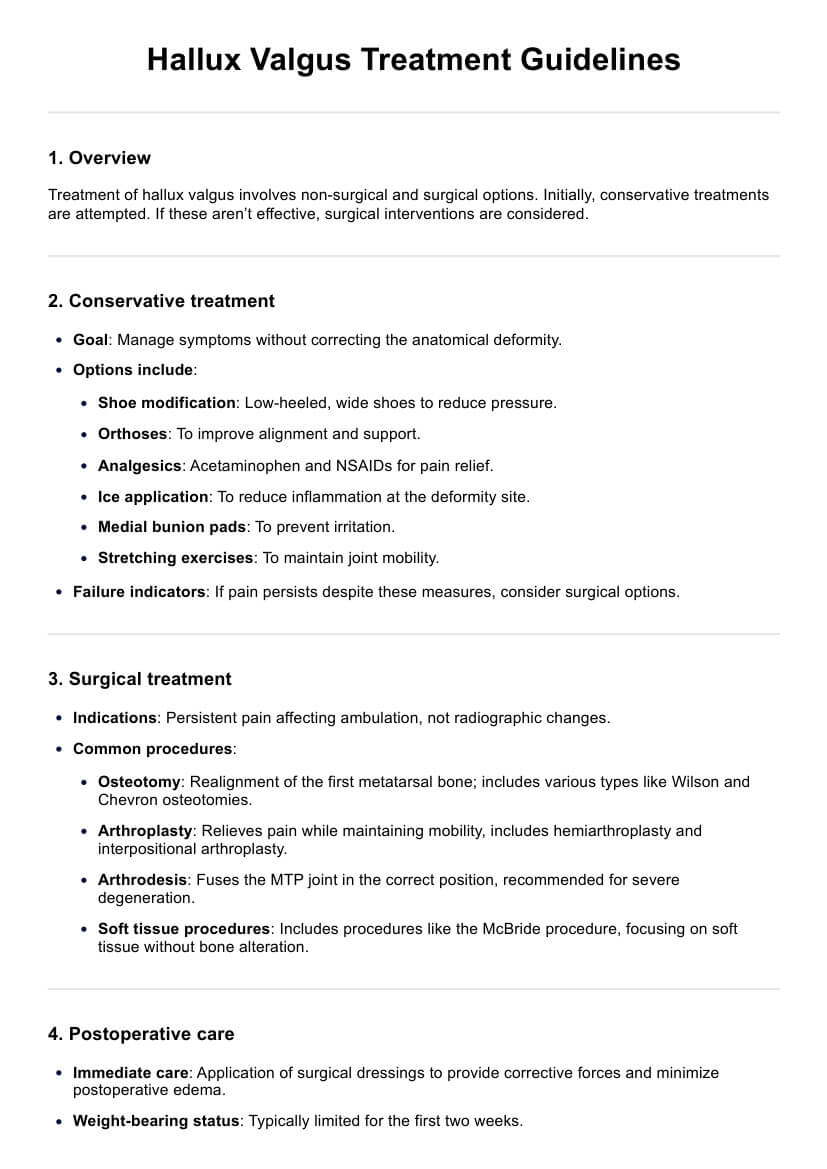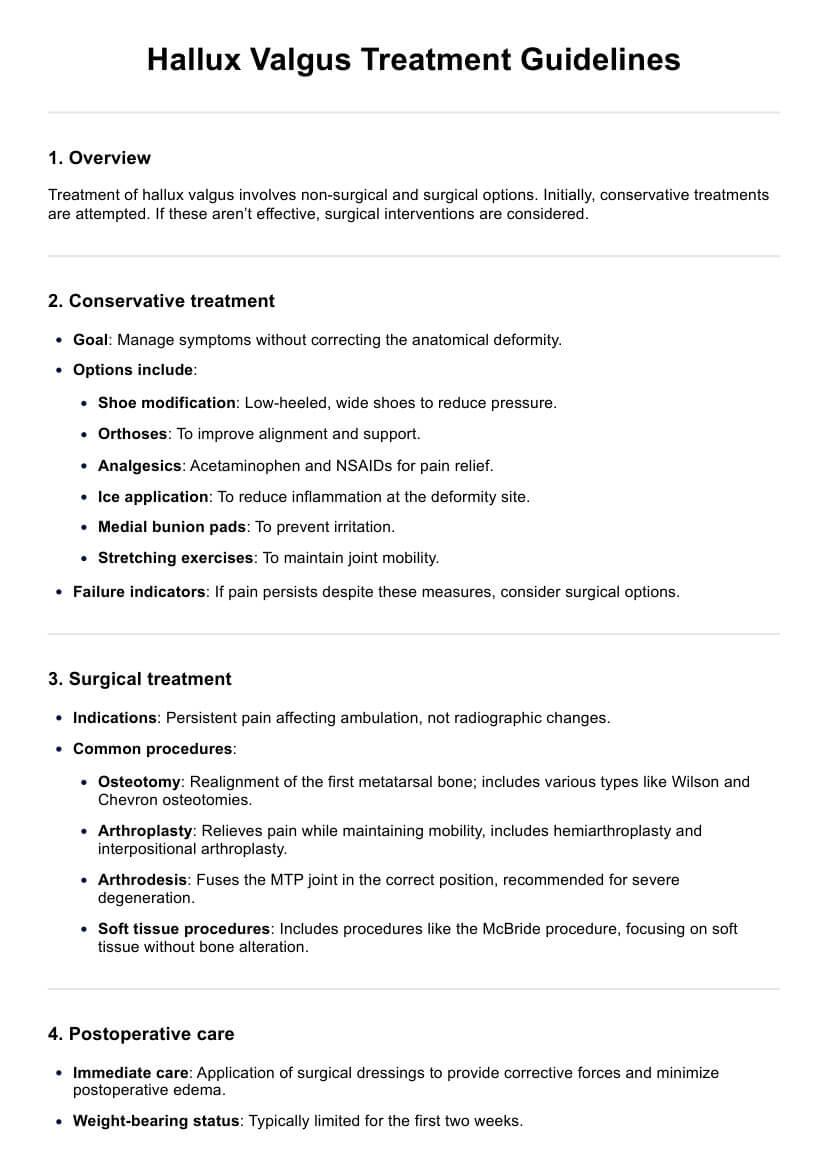Hallux Valgus Treatment Guidelines Handout
Explore effective treatments for hallux valgus, including both non-surgical methods and surgical options to manage pain and deformity.


What is hallux valgus deformity?
Hallux valgus, commonly known as a bunion, is a foot deformity involving the big toe joint. It occurs when the big toe begins to deviate inward towards the second toe, causing the joint at the base of the big toe to stick out and form a bony bump. This condition can lead to significant discomfort and other complications if not managed properly.
Types
Although hallux valgus generally refers to the deviation of the big toe, the severity and angle of deviation can vary:
- Mild: The big toe is slightly deviated. Non-operative treatment options for mild hallux valgus include insoles, footwear modification, and other conservative therapies for relieving symptoms and evaluating the progression of the deformity.
- Moderate: There is a noticeable deviation that may start to affect walking.
- Severe: The big toe significantly overlaps or underlaps the second toe, and the bunion is large and painful.
Causes
The specific cause of hallux valgus deformity is often multifactorial, involving a combination of genetic and environmental factors:
- Genetic predisposition: Many individuals with bunions have a family history of the condition.
- Footwear: Tight, narrow, or high-heeled shoes can exacerbate the development of bunions.
- Foot structure and biomechanics: Abnormal foot mechanics, such as flat feet or an abnormal gait, can increase the risk.
Risk factors for hallux valgus
Certain factors increase the likelihood of developing hallux valgus:
- Gender: Women are more prone to bunions, possibly due to footwear styles.
- Age: The risk increases with age.
- Arthritis: Conditions like rheumatoid arthritis can increase susceptibility.
Symptoms
Symptoms of hallux valgus include:
- Visible bump: The most obvious sign is the bump itself, which can become red, swollen, or painful.
- Pain and discomfort: Often aggravated by pressure from shoes or prolonged activity.
- Restricted movement: The toe’s mobility may decrease over time.
Hallux Valgus Treatment Guidelines Handout Template
Hallux Valgus Treatment Guidelines Handout Sample
Treatment for hallux valgus
Effective treatment of hallux valgus involves a combination of non-surgical and surgical methods, depending on the severity and progression of the deformity, as well as the patient's lifestyle and health status.
Non-surgical treatments
When treating hallux valgus non-surgically, these are often recommended for milder forms of painful hallux valgus. These treatments focus on relieving symptoms and preventing further progression of the bunion.
- Proper footwear: Shoes with a wide toe box, adequate support, and low heels are crucial to relieve pressure on the bunion and provide comfort.
- Orthotics: Custom orthotic devices can help redistribute pressure away from the affected joint and correct abnormal foot mechanics.
- Padding and taping: Bunion pads can protect the bunion from rubbing against the shoe while taping the foot can help keep it in a normal position.
- Medications: Nonsteroidal anti-inflammatory drugs (NSAIDs), such as ibuprofen, can help reduce pain and inflammation.
- Physical therapy: Exercises to maintain joint mobility and strengthen the foot muscles can also be beneficial.
Hallux valgus surgery
Surgery may be considered when non-surgical attempts at hallux valgus correction fail to relieve pain or when there is severe hallux valgus deformity.
- Osteotomy: This involves cutting and realigning the joint to correct the hallux valgus angle.
- Exostectomy: Removal of the bony bump on the joint without aligning the toe.
- Arthrodesis: Fusion of the affected joint to eliminate pain, used primarily in cases with severe arthritis.
- Lapidus procedure: Fusion of the joint near the base of the big toe to stabilize a more severe or recurrent bunion.
A chevron osteotomy is a type of distal osteotomy used to correct mild to moderate hallux valgus deformities. This technique involves a V-shaped cut in the first metatarsal and internal fixation with a screw. The metatarsal head plays a crucial role in these procedures, as its position and angles are evaluated through clinical and radiological presentations. Additionally, assessing the angle of the proximal phalanx is important in diagnosing and planning surgery for hallux valgus.
Each surgical option for severe hallux valgus deformities has its own risks and recovery times, depending on individual factors like the patient’s age and activity level.
How to use our hallux valgus treatment handout
Using our treatment guidelines handout template effectively ensures consistent, informed communication about hallux valgus management to patients and healthcare professionals. Here’s how to make the most of this resource:
Step 1: Download the handout
Start by downloading the template by clicking the 'Download PDF' button on this page.
Step 2: Educate your team
Ensure all team members understand the handout's content and how to use it effectively when discussing treatment options with patients.
Step 3: Implement treatment plan
Use the information in the handout to develop a customized treatment plan for patients managing hallux valgus.
Step 4: Monitor usage and effectiveness
Track how the handout is used and solicit feedback from patients. This feedback can help identify areas for improvement during the treatment of hallux valgus.
Step 5: Update as necessary
Regularly update the handout to reflect new research or changes in clinical practice guidelines. This ensures that the handout remains a valuable and up-to-date resource.
How can healthcare professionals benefit from our template?
Our Hallux Valgus Treatment Handout provides healthcare professionals with a concise, comprehensive resource for managing patients with hallux valgus. By integrating this handout into their practice, professionals can enhance patient education, ensuring patients understand their condition, the progression, and the various treatment options available.
Additionally, the handout serves as a quick reference guide, streamlining consultations and saving time. It includes guidelines on non-surgical and surgical treatments, post-operative care, and lifestyle recommendations, allowing for a holistic approach to patient care. By accessing up-to-date, evidence-based information at their fingertips, healthcare providers can make informed decisions more efficiently and foster a more interactive, informed dialogue with their patients.
Commonly asked questions
Hallux valgus is primarily caused by genetic predisposition, improper footwear, and abnormal foot mechanics, such as a flat foot or improper gait.
Yes, mild to moderate cases can often be managed with non-surgical treatments, such as proper footwear, orthotics, and physical therapy, to alleviate symptoms and prevent progression.
Recovery from hallux valgus surgery typically ranges from 6 weeks to 6 months, depending on the type of surgery performed and the patient’s adherence to post-surgical care instructions.







































































































